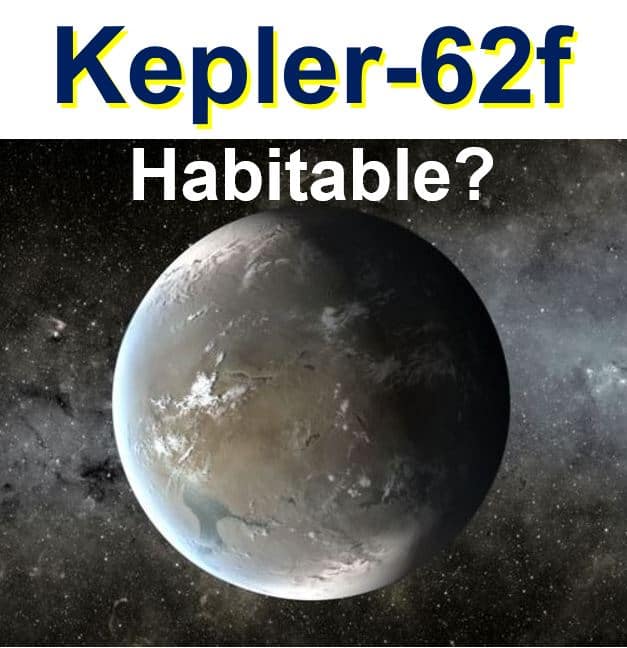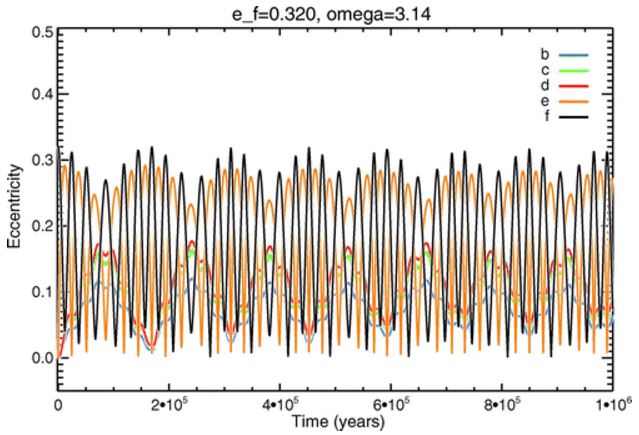An exoplanet 1,200 light-years from Earth might be able to sustain life, says a group of scientists, who describe Kepler-62f as a ‘good prospect for a habitable world’. For a world to be ‘habitable’ temperatures on the surface have to be just right for liquid water to exist.
Scientists from the University of California, Los Angeles, and the University of Washington, Seattle, explained in the journal Astrobiology that they combined climate and orbit models on this exoplanet, which is about 40% larger than Earth, and found that it might have the right environment to sustain life as know it.
Kepler-62f, which is approximately 1,200 light-years away in the direction of the constellation Lyra, is within the range of exoplanets that are likely to be rocky and could possibly have oceans, said lead author Aomawa Shields, a National Science Foundation astronomy and astrophysics postdoctoral fellow in UCLA’s Department of Physics and Astronomy.
 An artist’s depiction of Kepler-62f. Its atmosphere would need a very high concentration of carbon dioxide to maintain liquid water on its surface. (Image: newsroom.ucla.edu. Credit: NASA Ames/JPL-Caltech/T. Pyle)
An artist’s depiction of Kepler-62f. Its atmosphere would need a very high concentration of carbon dioxide to maintain liquid water on its surface. (Image: newsroom.ucla.edu. Credit: NASA Ames/JPL-Caltech/T. Pyle)
Scenarios created to determine whether life is possible
This exoplanet was discovered by NASA’s Kepler space observatory in 2013. It is the outermost of five planets orbiting a parent star that is cooler and smaller than our Sun. However, the mission produced no data on Kepler-62f’s atmosphere, composition, or the shape of its orbit.
Dr. Shields, together with Benjamin Charnay, Eric Agol, Cecilia Bitz, Rory Barnes and Victoria Meadows, all from the University of Washington, set out to determine whether Kepler-62f might be able to sustain life.
The team came up with possible scenarios regarding what its atmosphere might be like and what is orbital route might be.
 Evolution of the eccentricities of Kepler-62b–f as a function of time calculated with HNBody. (Image: Journal Astrobiology)
Evolution of the eccentricities of Kepler-62b–f as a function of time calculated with HNBody. (Image: Journal Astrobiology)
Dr. Shield said:
“We found there are multiple atmospheric compositions that allow it to be warm enough to have surface liquid water. This makes it a strong candidate for a habitable planet.”
On our planet, carbon dioxide (CO2) makes up 0.04 of the atmosphere. Given that Kepler-62f is much further away from its parent star than we are from the Sun, it would need to have considerably more CO2 to have enough of a greenhouse effect to warm up the planet so that liquid water could exist on its surface.
Dr. Shield and colleagues ran computer simulations on this exoplanet having:
– an atmosphere between one Earth atmosphere to 12 times thicker than Earth’s atmosphere.
– different CO2 atmospheric concentrations, ranging from 0.04% (like on Earth) to 2,500 times that level.
They found several scenarios in which the planet could be habitable, assuming varying quantities of atmospheric CO2.
Kepler-62f would need to have a lot of CO2
Dr. Shields said that for Kepler-62f to be habitable throughout the whole year, its atmosphere would have to be three to five times thicker than ours, and composed entirely of CO2.
The planet could have such a high concentration of atmospheric CO2, given how distant it is from its parent star. At that distance the gas could accumulate in Kepler-62f’s atmosphere as the temperature gets colder to keep the planet warm.
Dr. Shields added:
“But if it doesn’t have a mechanism to generate lots of carbon dioxide in its atmosphere to keep temperatures warm, and all it had was an Earth-like amount of carbon dioxide, certain orbital configurations could allow Kepler-62f’s surface temperatures to temporarily get above freezing during a portion of its year,” she said. “And this might help melt ice sheets formed at other times in the planet’s orbit.”
The team made their calculations of the planet’s orbital route using an existing computer model known as HNBody. To simulate its climate, they used existing global climate models (the Laboratoire de Me´te´orologie Dynamique Generic model and the Community Climate System Model).
The authors claim it was the first time scientists have combined results from these two types of models to study an exoplanet. An exoplanet is a planet outside our solar system.
According to Dr. Shield, the same technique could be used to understand whether exoplanets much nearer Earth could be habitable, as long as they are likely to be rocky.
Dr. Shields said:
“This will help us understand how likely certain planets are to be habitable over a wide range of factors, for which we don’t yet have data from telescopes.”
“And it will allow us to generate a prioritized list of targets to follow up on more closely with the next generation of telescopes that can look for the atmospheric fingerprints of life on another world.”
Dr. Shields believes there is life out there
Nobody has found any compelling evidence yet of life as we know it existing on an exoplanet. However, Dr. Shields and colleagues are optimistic about finding life in the Universe one day.
Over 2,300 exoplanets have been confirmed, and several thousand others are likely soon to be confirmed. However, only a couple of dozen are known to be in the Habitable Zone, also called the Goldilocks Zone, an orbital area around a star where a planet could have liquid water on its surface. Earth is in this Solar System’s Habitable Zone.
Citation: “The Effect of Orbital Configuration on the Possible Climates and Habitability of Kepler-62f,” Agol Eric, Charnay Benjamin, Shields Aomawa L., Barnes Rory, Bitz Cecilia, and Meadows Victoria S.. Astrobiology. May 2016, ahead of print. DOI: 10.1089/ast.2015.1353.
Video – NASA’s Kepler mission finds new exoplanets
NASA’s Kepler mission has detected 1,284 new exoplanets, including nine which might sustain life.
